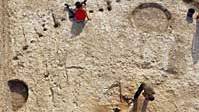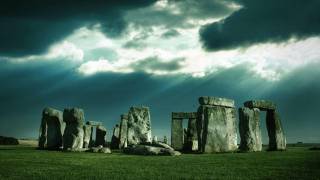Stonehenge builders' houses found
Source: news.bbc.co.uk
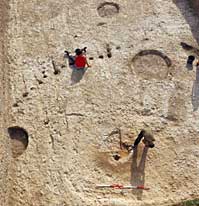 The village would have housed hundreds of people (Image: National Geographic) |
Excavations at Durrington Walls, near the legendary Salisbury Plain monument, uncovered remains of ancient houses.
People seem to have occupied the sites seasonally, using them for ritual feasting and funeral ceremonies.
In ancient times, this settlement would have housed hundreds of people, making it the largest Neolithic village ever found in Britain.
The dwellings date back to 2,600-2,500 BC - according to the researchers, the same period that Stonehenge was built.
But some archaeologists point out that there are problems dating Stonehenge itself because the stone circle has been rebuilt many times.
Consequently, archaeological material has been dug up and reburied on numerous occasions, making it difficult to assign a date to the original construction.
But Mike Parker Pearson and his colleagues are confident of a link.
"In what were houses, we have excavated the outlines on the floors of box beds and wooden dressers or cupboards," he explained.
The Sheffield University researcher said this was based on the fact that these abodes had exactly the same layout as Neolithic houses at Skara Brae, Orkney, which have survived intact because - unlike these dwellings - they were made of stone.
The researchers have excavated eight houses in total at Durrington. But they have identified many other probable dwellings using geophysical surveying equipment.
In fact, they think there could have been at least one hundred houses.
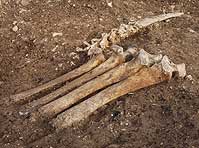 Animal bones were strewn on the floors of the houses (Image: National Geographic) |
"It is the richest - by that I mean the filthiest - site of this period known in Britain," Professor Parker Pearson told BBC News.
"We've never seen such quantities of pottery and animal bone and flint."
The Sheffield University researcher thinks the settlement was probably not lived in all year round. Instead, he believes, Stonehenge and Durrington formed a religious complex used for funerary rituals.
He believes it drew Neolithic people from all over the region, who came for massive feasts in the midwinter, where prodigious quantities of food were consumed. The bones were then tossed on the floors of the houses.
"The rubbish isn't your average domestic debris. There's a lack of craft-working equipment for cleaning animal hides and no evidence for crop-processing," he said.
"The animal bones are being thrown away half-eaten. It's what we call a feasting assemblage. This is where they went to party - you could say it was the first free festival."
Pigging out
Durrington has its own henge made of wood, which is strikingly similar in layout to Stonehenge. It was discovered in 1967 - long before any houses.
Both henges line up with events in the astronomical calendar - but not the same ones.
Stonehenge is aligned with the midwinter solstice sunset, while Durrington's timber circle is aligned with the midwinter solstice sunrise - they were complementary.
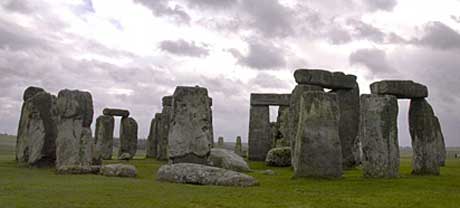
This seems to fit with the idea of a midwinter festival, in turn supported by analysis of pig teeth found at the site.
"One of the things we can tell from the pig teeth we've looked at is that most of them have been slaughtered at nine months. And we think they are farrowing in Spring," he said.
"It's likely there's a midwinter cull and that ties in with our midwinter solstice alignments at Durrington and Stonehenge."
Sacred monument
Professor Parker Pearson believes Durrington's purpose was to celebrate life and deposit the dead in the river for transport to the afterlife. Stonehenge was a memorial and final resting place for some of the dead.
After feasting, he speculated, people travelled down the timber circle's "avenue" to deposit their dead in the River Avon flowing towards Stonehenge. They then moved along Stonehenge's avenue to the circle, where they cremated and buried a select few of their dead.
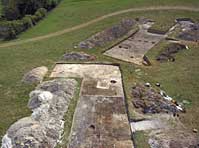 The researchers say they will find many more houses (Image: National Geographic) |
But not all archaeologists agree: "I see Stonehenge more as a living monument," archaeologist and broadcaster Julian Richards told BBC News 24.
"So in terms of broad understanding of the landscape I'm not in total agreement."
Dr Andrew Fitzpatrick, from Wessex Archaeology, who was not a member of the research team, commented: "There haven't been many excavations near Stonehenge in recent years and the new work will stimulate exciting new theories in coming years.
"But we shouldn't forget that Stonehenge became special when people brought the stones from Wales, 250km away. Some of the answers about Stonehenge aren't just to be found in Durrington, but further afield."
Stonehenge was the largest cemetery in Britain at the time, containing about 250 ashes from cremations.
In a separate area, further up the valley from Durrington Walls, Julian Thomas of Manchester University, discovered two other Neolithic houses. But these were free of rubbish.
The researchers think these dwellings were deliberately kept clean. They could have been home to community leaders, or they might have been sacred sites, where rituals were performed.
Article from: http://news.bbc.co.uk/1/hi/sci/tech/6311939.stm
